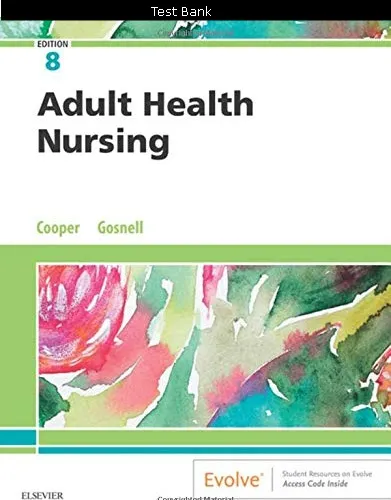Foundations And Adult Health Nursing 8th Edition Cooper Test Bank
$55.00 Original price was: $55.00.$18.00Current price is: $18.00.
Digital item No Waiting Time Instant Download
Chapters: 17
Format: PDF
ISBN-13: 978-0323484381
ISBN-10: 0323484387
Publisher: Elsevier
Authors: Kim Coope, Kelly Gosnell
Description
Adult Health Nursing 8th Edition Test Bank
Table of Contents
1. Introduction to Anatomy and Physiology
2. Care of the Surgical Patient
3. Care of the Patient with an Integumentary Disorder
4. Care of the Patient with a Musculoskeletal Disorder
5. Care of the Patient with a Gastrointestinal Disorder
6. Care of the Patient with a Gallbladder, Liver, Biliary Tract, or Exocrine Pancreatic Disorder
7. Care of the Patient with a Blood or Lymphatic Disorder
8. Care of the Patient with a Cardiovascular or a Peripheral Vascular Disorder
9. Care of the Patient with a Respiratory Disorder
10. Care of the Patient with a Urinary Disorder
11. Care of the Patient with an Endocrine Disorder
12. Care of the Patient with a Reproductive Disorder
13. Care of the Patient with a Visual or Auditory Disorder
14. Care of the Patient with a Neurological Disorder
15. Care of the Patient with an Immune Disorder
16. Care of the Patient with HIV/AIDS
17. Care of the Patient with Cancer
References
Glossary
Chapter 01: Introduction to Anatomy and Physiology
Cooper: Adult Health Nursing, 8th Edition
MULTIPLE CHOICE
1. The anatomic term ____ means toward the midline.
a. anterior
b. posterior
c. medial
d. cranial
ANS: C
The term medial indicates an anatomic direction toward the midline.
DIF: Cognitive Level: Knowledge REF: 1 OBJ: 2
TOP: Anatomic terminology KEY: Nursing Process Step: Assessment
MSC: NCLEX: Physiological Integrity
2. What are the smallest living components in our body?
a. Cells
b. Organs
c. Electrons
d. Osmosis
ANS: A
Cells are considered to be the smallest living units of structure and function in our body.
DIF: Cognitive Level: Knowledge OBJ: 6
TOP: Structural levels of organization KEY: Nursing Process Step: N/A
MSC: NCLEX: Physiological Integrity
3. What is the largest organelle, responsible for cell reproduction and control of other
organelles?
a. Nucleus
b. Ribosome
c. Mitochondrion
d. Golgi apparatus
ANS: A
The nucleus is the largest organelle within the cell.
DIF: Cognitive Level: Knowledge REF: 5 OBJ: 8
TOP: Parts of the cell KEY: Nursing Process Step: Assessment
MSC: NCLEX: Physiological Integrity
4. When the patient complains of pain in the bladder, the patient will indicate discomfort in
which body cavity?
a. Pelvic
b. Mediastinum
c. Dorsal
d. Abdominal
Foundations and Adult Health Nursing 8th Edition Cooper Test Bank
ANS: A
A subdivision called the pelvic cavity contains the lower portion of the large intestine (lower
sigmoid colon, rectum), urinary bladder, and internal structures of the reproductive system.
DIF: Cognitive Level: Comprehension REF: 3 OBJ: 5
TOP: Body cavity KEY: Nursing Process Step: Assessment
MSC: NCLEX: Physiological Integrity
5. The four phases of cell division all occur in:
a. diffusion.
b. mitosis.
c. osmosis.
d. filtration.
ANS: B
During mitosis, the cell goes through four phases: prophase, metaphase, anaphase, and
telophase.
DIF: Cognitive Level: Knowledge REF: 7 OBJ: 9
TOP: Cell division KEY: Nursing Process Step: N/A
MSC: NCLEX: Physiological Integrity
6. Telophase is which phase of cell reproduction during mitosis?
a. First phase
b. Latent phase
c. Final phase
d. Spindle phase
ANS: C
During this final phase of cell division, the two nuclei appear and the chromosomes disperse.
DIF: Cognitive Level: Knowledge REF: 7 OBJ: 9
TOP: Cell division KEY: Nursing Process Step: N/A
MSC: NCLEX: Physiological Integrity
7. The nurse is aware that which muscle group is both striated and involuntary?
a. Skeletal
b. Glial
c. Cardiac
d. Visceral
ANS: C
The cardiac muscle is both striated and involuntary.
DIF: Cognitive Level: Knowledge REF: 9 OBJ: 11
TOP: Tissues KEY: Nursing Process Step: Planning
MSC: NCLEX: Physiological Integrity
8. What is a group of several different kinds of tissues arranged so that together they can
perform a more complex function than any tissue alone?
a. Organ
b. System
Foundations and Adult Health Nursing 8th Edition Cooper Test Bank
c. Cell
d. Endoplasmic reticulum
ANS: A
When several kinds of tissues are united to perform a more complex function than any tissue
alone, they are called organs.
DIF: Cognitive Level: Knowledge REF: 11 OBJ: 7
TOP: Organs KEY: Nursing Process Step: N/A
MSC: NCLEX: Physiological Integrity
9. What traits describe visceral muscles?
a. Smooth and voluntary
b. Smooth and involuntary
c. Striated and voluntary
d. Striated and involuntary
ANS: B
Visceral (smooth) muscles will not function at will; thus, they act involuntarily.
DIF: Cognitive Level: Knowledge REF: 9 OBJ: 7
TOP: Tissues KEY: Nursing Process Step: Assessment
MSC: NCLEX: Physiological Integrity
10. How are the thoracic and abdominal cavities separated?
a. By the pleura
b. By the diaphragm
c. By the sagittal plane
d. By the peritoneum
ANS: B
The diaphragm (a muscle directly beneath the lungs) separates the ventral cavity into the
thoracic (chest) and abdominal cavities.
DIF: Cognitive Level: Knowledge REF: 2 OBJ: 3
TOP: Ventral cavity KEY: Nursing Process Step: Assessment
MSC: NCLEX: Physiological Integrity
11. What is the broad section of biology dealing with the description of human structure?
a. Hematology
b. Anatomy
c. Kinesiology
d. Physiology
ANS: B
Anatomy is the study, classification, and description of the structure and organs of the body.
DIF: Cognitive Level: Knowledge REF: 1 OBJ: 1
TOP: Terminology KEY: Nursing Process Step: N/A
MSC: NCLEX: Physiological Integrity
12. ____ explains the processes and functions of many structures of the body and how they
interact with one another.





Be the first to review “Foundations And Adult Health Nursing 8th Edition Cooper Test Bank”